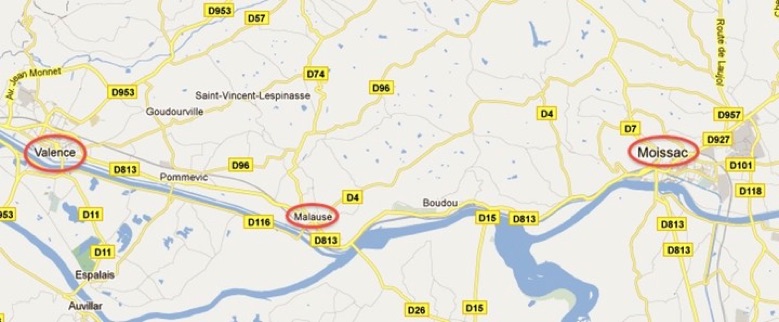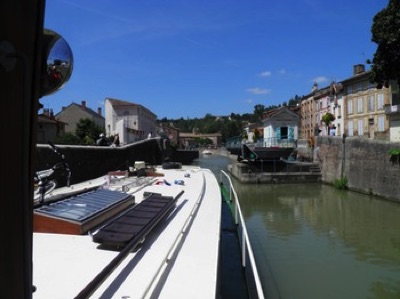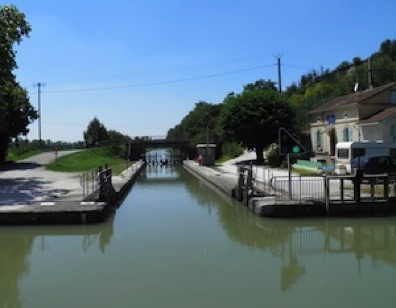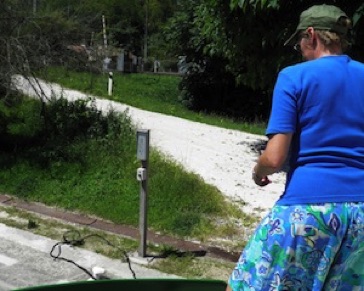
Thursday 4 August - the Big Day, away we go to Malause, then Valance d'Agen
Today was the big day - we were heading off in Kanumbra. But because it had been so long since our training in April, Rita asked Iain and Kaz if they would come along with us for the first few locks and give us a refresher course and some tips. They readily agreed and were happy to be on a moving barge, away from the port!
Our route would take us from Moissac to Valence d'Agen, with a short stopover in Malause.

The first thing we had to do was to get out of Moissac, and that involved going through the swing bridge in the middle of town. This is controlled by VNF staff at the bridge and they are forewarned of our arrival by the central monitoring system located in Moissac. So after waiting till everyone was back at work after an extended lunch, we cruised up to the bridge to await passage. As we approached, the lights turned green and the bridge began to open. Even when fully open, the gap on the left looked really small, but we made our way through without incident, and headed west from Moissac.

Soon we were at our first lock. Luckily, the locks going west are all descending locks, which makes things a bit easier. On the approach to the lock, there is a "twister" hanging over the middle of the canal. The skipper slows the barge and aims one side or other of the barge so that the twister runs down the side as we pass by. The deckhand grabs the twister and gives it a good twist either way (thus closing a circuit and telling the lock that we are approaching). If no-one is in the lock or no-one coming the other way has already used their twister, then the lock is prepared for our entry, after which the lights turn green to signal that we can enter.

Now what did Jerry say about how to approach the lock? Right, reduce some speed but keep it moving to retain steerage. Line up the bow with the middle of the back gates. Go back to neutral as the bow enters the lock. Halfway into the lock go to reverse, and slow the barge so that the bow stops near the bollard you want to tie onto.

The deckhand now throws the rope over the bollard (notice how Rita got this done first time with her "hallelujah"). Wait until the deckhand has made fast on the front bollard, then turn the rudder to hard port (you can see from the photo that we will be coming in on the starboard side in the lock, by the location of the control box), and give some gentle forward thrust to spring off the bow rope and push the stern into the dock.

By this time, the deckhand will have got back to the stern and repeated the process with the stern ropes (under Iain's watchful supervision this time around). When all is secure, throttle back to neutral. The deckhand can now step ashore and push the green button to start the locking process, then step back on board, go to the bow rope and release it from the boat's bollard, but hold it fast. The skipper does the same with the stern rope. As the barge drops, let out rope from the bollard, making sure at all time that the ropes don't cross or jam. Once the barge has fully descended and the front gates open, release the stern rope, turn the rudder to slight starboard, signal the deckhand to release the bow rope, then a short forward burst to kick the stern away from the dock (and maybe a short bowthrust to do the same for the bow, or else just pole away), straighten the rudder and move forward. Keep an eye out the side doors to monitor the position of the boat within the lock as you move out, using the rudder to adjust the position of the stern, and the bowthruster for the bow (if you've got one you may as well use it!)

Well, all that seemed to go well, and so we went through another lock with Kaz & Iain, before we reluctantly had to say goodbye to them at Malause. From now on, it was just Rita, Frank and me!
And so we wandered on, negotiating another three locks that day without major disasters (but learning a lot each time) until we reached Valence d'Agen. When we got there, we checked out the port area, but it was all "90degree parking" (not easy for a 17m barge) and besides it was full. So we slipped through the town and tied up by the bank a couple of hundred metres downstream. But this seemed better to us anyway; it was in the shade, it was quieter, and it was free! Here we got to practice another technique shown to us by Jerry on Vertrouwen on those nights when we had moored bankside in April. Two short ropes to spikes forward and back of the barge, then long "stringers" from the stern bollard to the front bank, and from the bow bollard to the rear bank. Then put the gangplank over the stringers to prevent anyone tripping on them as they board or alight.


And so, after going into the village for some dinner, we settled down for the first of many quiet nights on the bank of a canal.
